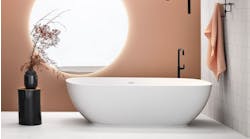Latest from Plumbing
Sponsored
BY ROBERT P. MADER of CONTRACTOR’s staff
MISSISSAUGA, ONTARIO — Plumbing engineer John Koeller of California and Canadian engineer Bill Gauley of Veritec Consulting here have issued their third edition of “Maximum Performance Testing of Popular Toilet Models.” In addition, the two have published a supplemental report, “Evaluation of Water-Efficient Toilet Technologies to Carry Waste in Drainlines.”
As usual, the reports raise as many questions as they provide answers.
The test protocol for the MaP tests is to flush soybean curd formed into 50-gram “logs” and a four crumpled wads of six sheets each of single-ply toilet paper meeting the specifications set forth in ASME Standard A112.
Based on an old British medical study, Koeller and Gauley knew that the average human fecal size is 130 grams and an average maximum for a male is 250 grams. The engineers decided that a satisfactory toilet must be able to consistently flush 250 grams or more. The toilets are loaded with bean curd in 50-gram increments and flushed until they are so loaded that they fail.
When the pair first performed the bean curd test back in 2003, the top flusher was the Toto Drake that downed 900 grams, followed by the Crane VIP Flush at 725 grams (August 2003, pg. 7). This year the winner is one of the versions of the Mansfield Quantum at 925 grams. That converts to about 2 lb., a prodigious load for both a toilet and its user.
What’s striking about the results is how different they are when tanks or bowls are changed for the same model of toilet. There are three pressure-assisted Mansfield Quantum toilets near the top of the list, flushing from 925 to 825 grams, depending on what tank is used. The same can be said for almost every manufacturer.
Crane has a VIP Flush that moves 725 grams, but a change in the bowl from another model moves it down to 350 grams. One Eljer Patriot flushes 425 grams, another 150. One American Standard Cadet moves 750 grams, but two others flush 125 and 150 grams.
The researchers found that the toilets were often not 1.6-gpf toilets when the water level was set to the water line inside the tank. Some toilets flushed less, some more, and the worst offender was a Komet Deco that flushed 2.51 gal. when set to the waterline.
Gerber Plumbing Vice President Ron Grabski said he believes that toilet tests are too variable to be credible.
“While it [the test] seems repeatable, some of the soybean pieces break and some don’t, and while that’s what happens in the real world, it’s not really a repeatable test,” Grabski said. “You can get two different results.”
Kathryn Streeby, Kohler senior product manager for toilets, said the same thing after the first round of tests in August 2003. Kohler pretty much ignores the tests, she said. Instead, a group of about 15 people from engineering, marketing and manufacturing change their toilets every few months and compare notes about various makes and models.
“They don’t test nearly enough samples, which is understandable because of the expense involved and the time to do this carefully and accurately,” said Pete DeMarco, director of compliance engineering for American Standard.
DeMarco said that while all the engineers who have been testing toilets for Veritec, National Association of Home Builders and Consumer Reports are brilliant engineers, they are undone by the enormity of the task. Because some of these toilets are manufactured in the millions, DeMarco believes at least 30 toilets of a single model would have to be tested to achieve statistical significance.
DeMarco’s advice to plumbing contractors is, “Nothing they read in these test reports should overrule the real-world experience they have had with these toilets.”
The drainline carry study tested toilets by type: gravity with a 3-in. valve; gravity tipping buck (a Niagara model); gravity siphon jet in trapway; gravity siphon jet in sump of bowl; gravity rim jet; gravity vacuum assist; pressure-assisted 1.6-gpf; and pressure-assisted 1.0-gpf. They tested drainline slopes of flat, 1% and 2%, 3-in. and 4-in. pipe diameters, and vertical drops of 6 in. and 35 in.
In an ideal world, the best drainline carry came from a 1.6-gpf pressure-assisted toilet flushing through a 3-in. pipe at a 2% slope. In the real world, however, the researchers noted the difficulty of achieving a 2% slope with the 2-in.-by-8-in. beams that are standard in most construction. The test media was also drained through clear, smooth-walled plastic pipe.
Gauley included many of his own questions at the beginning of the report for which he didn’t have the time or funding to study. What about cast iron vs. plastic or old pipe, Gauley asked at the beginning of his report. He’s also expressed curiosity about the effects of different pipe couplings, supplemental flows, sanitary napkins, larger loadings of toilet paper, and comparisons against different test media and methodologies.

